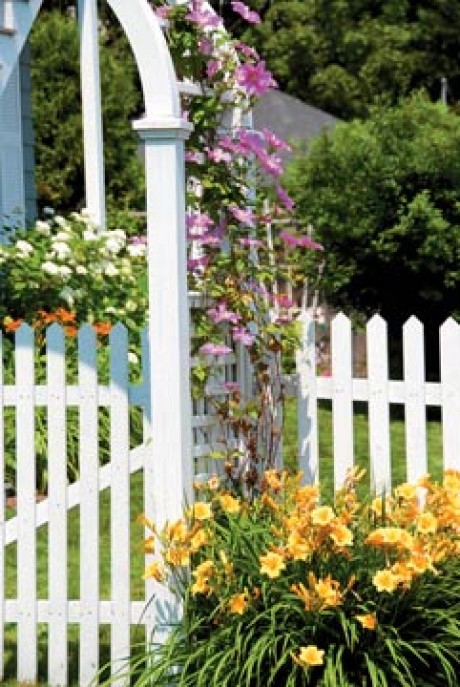Garden Gates

Gates have always been a big part—sometimes a bedeviling part—of my life. When I was a child, I learned to open and close those wobbly post-and-wire Texas gaps from horseback. I discovered that a little bump of the hip and a just-so lift would open those sagging metal gates on my grandfathers' farms wide enough to let the pickup truck through. And it was ingrained in me from an early age to make sure each gate was latched behind me to keep the dogs, horses or cattle that populated our lives and lands from escaping.
These days, however, the only gate I deal with is a fuss-free chain-link one that leads to the pen of our three-legged dog, Oscar. We learned the hard way that, despite his disability, Oscar is swift-footed and prone to dashing through an open gate, so I am thankful that it's an easy gate to manage. But I have been dreaming this winter of another kind of gate, one to welcome the world rather than keep something in or out—a garden gate.
Now gates, by nature, are supposed to be utilitarian. They were developed, according to historians, at the same time that humans began to erect walls for protection (no big surprise there, eh?), so gates originated as tools that controlled access or shut out the world.
While a garden gate may serve the very same functions—an outdoor doorway that provides access to the garden while also keeping out the riff-raff—it has the lovely advantage of also being an element of art in a landscape and has potential to be ever-so welcoming. A garden gate may provide a line of view into a garden or serve as a transition between outdoor "rooms," and it can be the focal point of your garden or landscape. It can be as simple or as complicated as you want, ranging from two sentinel posts with no real gate, to close to a trellis, to a roofed pergola and a bench for relaxing.
Function vs. Form
In researching my dream gate plan, the first thing I learned was that a garden gate needs to be functional as well as beautiful. If you are thinking of a gate for your own garden space, ask yourself the following questions. Does the gate need to keep animals—four-legged, three-legged or even two-legged—in or out? Does it need to be lockable to keep little two-legged critters from trespassing or escaping? Or, is its function more art than utility? Could it simply be an open arbor that defines an entryway, or does it need to provide a screen of privacy for your garden space? Does it need to match an existing fence or landscape design? And are there neighborhood rules and regulations that may dictate your gate style choices?
Answering these questions in advance allows you to choose a gate style that is appropriate for your needs. Once you have an idea of the use and style of gate you want, it's time to get into the details. One good idea I ran up on in my research is to take pictures of the garden or landscape from all sides and angles, including views from the house where the gate might be visible. My source suggests that black and white photos are better than color photos because black and white helps spot assets and flaws in the location or landscape design without the distraction of color.
Once you have picked the perfect spot of the gate, sketch a picture of your dream gate adding any details you may want to include, such as whimsical touches of lattice, stained glass, woodwork, metal embellishments or paint. And think about what you want to plant around the gate, such as climbing roses or other vines or shrubs that will compliment the design. If you're drawing impaired, collect photos of garden gates from magazines and books and use those as your blueprints.
Garden gates can be made of almost anything, from bamboo to metal, wood to PVC or chicken wire (though it may take a special creative flair to make the chicken wire and PVC aesthetically pleasing) to simply an airy entryway with side posts but no real gate at all.
Some people use recycled materials or pieces of old barn wood for their gates, or reuse antique wood or metal gates that they found at yard sales or antique and junk stores. Others have wood or metal artists design and create one-of-a-kind gates. Still others take the do-it-yourself route and build their own using pre-packaged garden gate plans or their own design-build talents. The options are limited only by your budget, talents and style needs.
The Technical Aspects
A garden gate should be at least three feet wide, and up to four feet in width. If you want a wider gate space, consider putting in a double-sided gate and definitely plan to provide extra support from the gate posts.
Gate posts should be sturdy, straight and plumb and should be sunk at least two feet into the ground—three feet for wider or heavier gates—and perhaps even reinforced with concrete footings. Make sure you use treated lumber if you are using wooden posts so they won't rot or be taken out by termites.
An abundance of gate building plans exist, so look for them in bookstores, garden centers, through your local Extension System office and on the Web. And plan to buy all your gate building supplies at one time so you won't be running back and forth to the store too often. This will also ensure that you have matched the hardware (hinges and latches) to the design and support needs of your gate.
-
Share this story:


